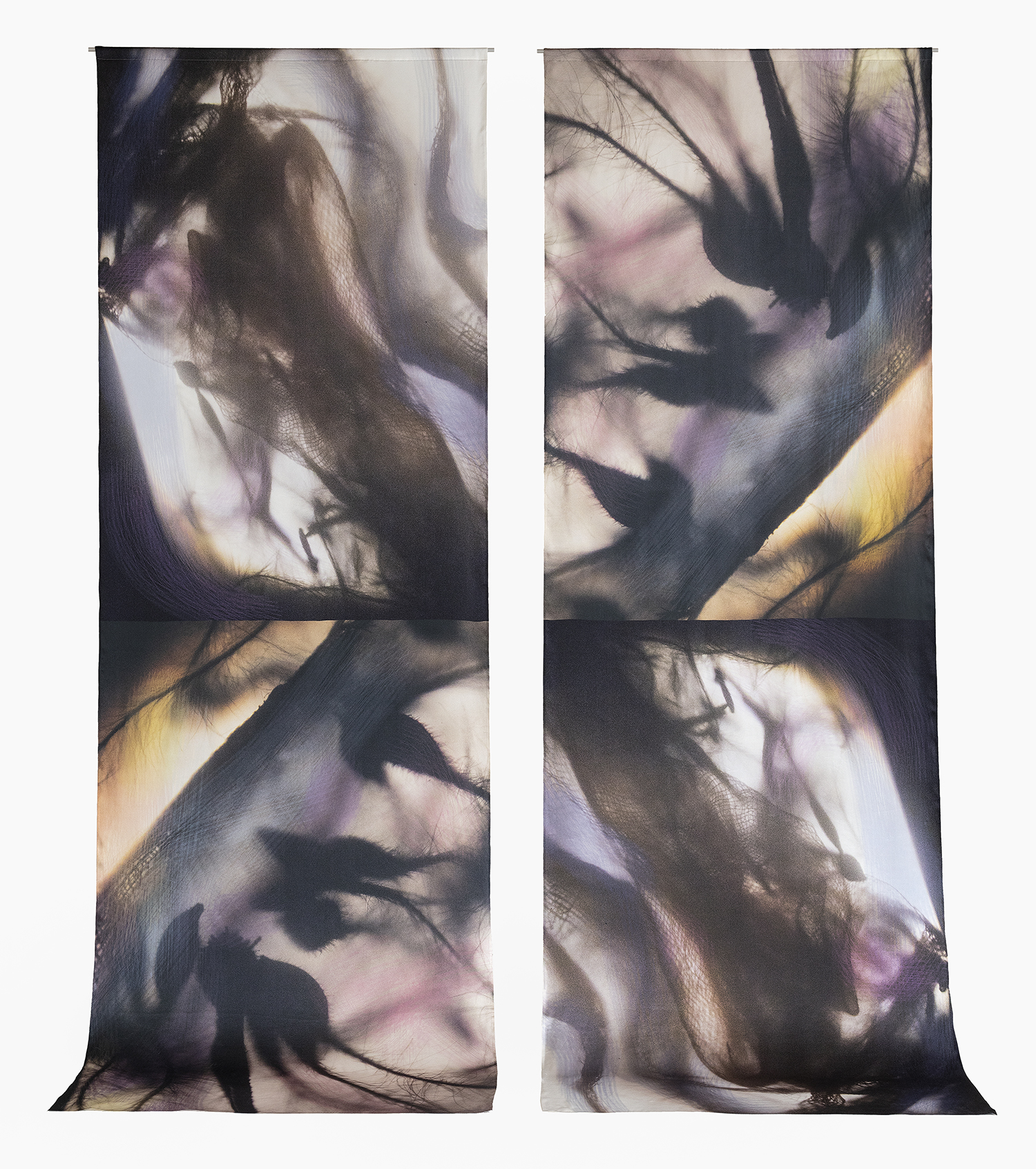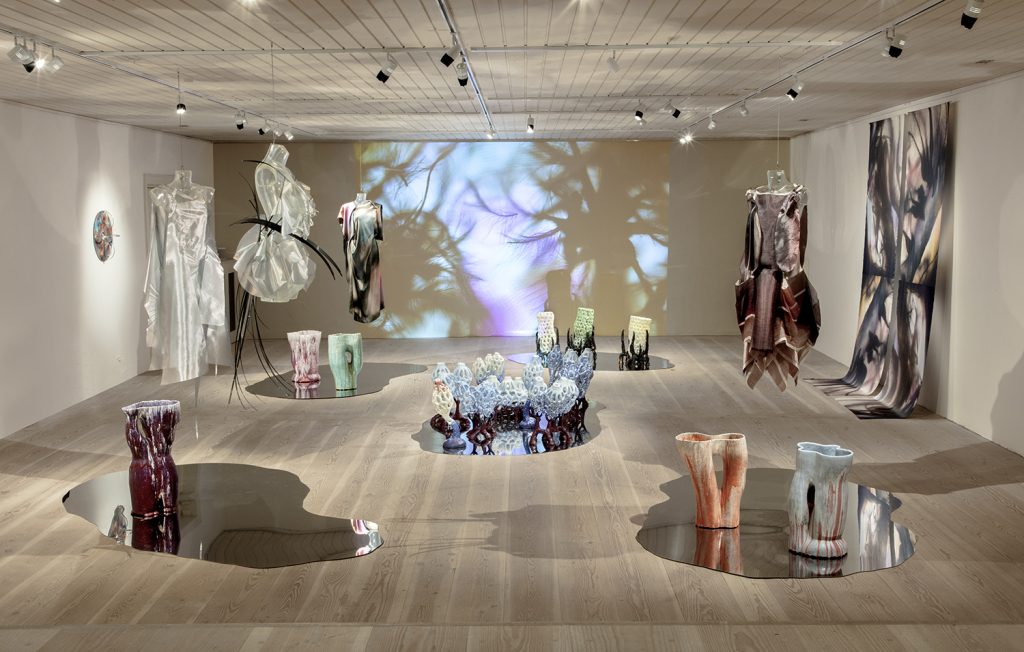Everything Flows
In a display created specially for Museet Holmen’s unique exhibition space, which visitors enter and descend into, the two artists have created an artistic universe that revolves around the general condition of impermanence.
The exhibition is a total installation of ceramic forms and floating dresses and textiles reflected like underwater creatures in organic lakes and bathed in light projections and sound.

Invitation to Duration
By Anne Blond
‘Something new emerges in the encounter of our works,’ says one. ‘It’s a positive clash,’ says the other. But what is it that happens that is so impactful that textile artist Anne Damgaard and ceramic artist Bente Skjøttgaard have now, once again, joined forces to create their third joint exhibition? Such a joint endeavour is not a common occurrence in the art world. There are many group exhibitions, and artist duos are not a rarity either. But in this presentation, although the works are displayed in their own right, the exhibition as a whole clearly demonstrates that by joining forces they have achieved something other than either of them could have achieved on her own.
In the essay Light and Heat /Black and White, the English painter Ian McKeever reflects on the nature of art by considering how visual art relates to light and dark, which, to him, is a fundamental condition of the creative process. McKeever describes that Vermeer painted towards the light, while Hammershøi painted towards the night, and O’Keeffe brought light into her paintings through her use of an enigmatic, translucent white sheen that made her forms float on the canvas in defiance of gravity. ‘The French religious thinker Simone Weil believed that two forces, light and gravity, rule the universe; the one elevating, the other rooting us back down to the ground. (…) And perhaps, one of the main impulses behind all painting is the desire to rise above our mundane condition, countered by the need to hold onto and define the physical world,’ writes McKeever. Although his reflections pertain to painting, the same desire is evident in the works of Damgaard and Skjøttgaard, which spring from the applied art tradition.
In the exhibition Everything Floats, a total installation in which Damgaard’s featherlight textile creations meet Skjøttgaard’s stoneware sculptures, it is precisely this desire or the clash of these opposite forces that is in play.
Their works seek at once to rise above their condition by reaching for what our consciousness can barely grasp and to hold onto and explore the physical world by going to the very limits of what is materially and constructively possible in artistic form and by choosing content themes from the physical world that are familiar yet also enigmatic to most of us: Damgaard’s transparency and fleeting effects of light and shadow and Skjøttgaard’s underwater jellyfish and fungi.
Damgaard’s textile artworks float in softly falling swirls, ripples and geometric shapes, manifested in fabric whose direction of movement is unpredictable, even though its point of departure is the most familiar form of all: the female body. However, the body disappears in waves of colour, waves of textile transparency and waves of nothing – the constructively emerged gaps, spaces and openings that combine with the effects of light and shadow to effect the dissolution, transparency or transformation of the material substance and relegate the body to a supporting role.
With its physical weight, Skjøttgaard’s ceramic art is rooted to a stable surface, usually the ground or, as here, the seabed. Her works spring from the soil, or a form of soil: clay. She lets them grow forth, organically, in her hands, allowing them to find their form by following nature’s own vital forces. In finishing her ceramic pieces, however, she uses a non-natural – or, as she puts it, non-ceramic – glaze colour in order to preserve a sense of otherness, a novel quality that challenges and updates our preconceived notions of stone.
In a spatial effect, the installation also features an art video by Damgaard with a soundtrack by Søren Buhl Lassen. The video envelops the room in a slow kaleidoscopic atmosphere of sound, colours, light and shadow pictures. Something emerges, as something else dissolves. On the floor, five floating mirror islands add to the film’s effect of dismantling space and time as we know them – space as something we can orient ourselves in and time as something that can be monitored by a timepiece.
In this way, the installation establishes a universe of the beginning or the end of everything. The artistic impact feels similar to the experience of accepting the Danish systemic poet Inger Christensen’s invitation to enter her Butterfly Valley. Here, existence is in a state of fluid transition with the world around us. The world does not feel like something around us or within us but rather as something we have fused with through our senses. We sense a state of becoming, of constant change – what the French philosopher Henri Bergson calls la durée: duration.
Duration is our inner perception of time, in which the boundaries between past, present and future are fluid because consciousness or the living always is. Time, moments, periods can no longer be spatially delimited. Time is not a sequence of stages of movement in space. Time is in motion – duration that can only be experienced but never registered or captured. It arises when subject and object fuse into one, when we fuse with the exterior world around us and the interior world inside us. This is what McKeever describes as the desire to rise above our mundane condition while also holding onto the physical world. It is the state Inger Christensen evokes in her Butterfly Valley and which Damgaard & Skjøttgaard go in search of in Everything Flows.
It is the very reason why everything floats. Providing neither a fixed space nor a fixed time, through a broad and diverse aesthetic experience, the exhibition offers a sense of materiality, tactility and colour and an entrance into a different sensory state of being.
In order to achieve this, Damgaard & Skjøttgaard use each other’s differences, respective artistic media, distinct areas of knowledge and individual points of departure in the shapes of geometry and nature. These differences notwithstanding, their approaches have a significant shared foundation in their use of logbooks. A scientifically recording eye observing craft experiments and either meticulously photographing the stages of dress forms, effects, light and shadow, fabric samples and so forth or tracing the effects and colours of glaze in a folder system. Skjøttgaard also uses what the English sculptor Henry Moore would have called maquettes: miniature versions of sculptures that she scales up to full size if she is satisfied with them. In the present exhibition, as in her previous exhibitions, Skjøttgaard also channels her fascination with the natural scientists of the latter half of the 19th century and their meticulous registrations of biological phenomena, particularly the German biologist Ernst Haeckel’s drawings of jellyfish and fungi.
To Damgaard and Skjøttgaard, these sources of inspiration serve as scientific studies or experiments that, as Damgaard puts it, bring greater freedom to the artistic process.
The two artists share this scientific point of departure with Inger Christensen, who once said in an interview, ‘I really don’t feel like a poet but rather as a sort of rightness writer. To me, writing poetry is a form of science, even though it has a different set of criteria.’
This is beautifully exemplified by Butterfly Valley. While its content offers scientific descriptions of butterflies, in form, it is a systemic poem, confined to a specific structure. In this case, the structure is that of a sonnet redoublé, a format in which each sonnet begins with the last line of the preceding sonnet, while the final sonnet is made up entirely of the first line of each of the preceding sonnets. Thus, the sonnets flow into one another and finally fuse into an impressive whole, like the works of art in Everything Flows.
Now, that is impactful, and Damgaard and Skjøttgaard achieve this impact by working individually yet together.
Danish Arts Foundation





